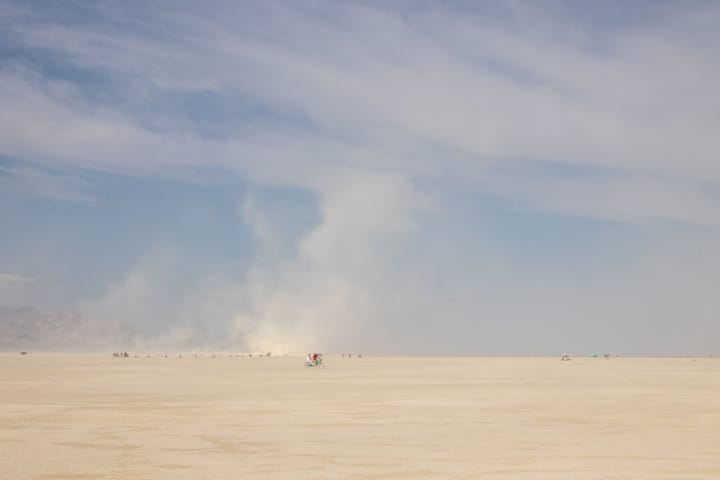Dust
Black Rock City, NV, USA
The weather in Black Rock Desert can be surprisingly varied. Past years have seen baking heat, freezing cold, rain and even snow. The one constant is the dust.
Black Rock City is built on a dry lake bed. The lake bed is filled with silt which dries, cracks, and blows away as fine dust. The dust is as fine as flour: biking across the flat lake bed – ‘the playa’ – the hard-as-rock surface intermittently gives way to shallow patches of dust and your forward motion slows abruptly as your tires sink in.
The dust quickly coats everything and everyone. Within hours, clothing turns white and stays that way. The dust is highly alkaline, unpleasant to breathe or to have on your skin (walk around barefoot and you risk a nasty chemical burn), and damaging to electronics or anything with small moving parts. I sealed my camera in a special ‘camera condom’ in an attempt to protect it. It worked well, although manipulating the camera controls through a casing of clinging silicone rubber was not easy.
The dust is restless. The least gust of wind raises whirlwinds of dust from the playa surface. The Paiute, on whose lands the desert lies, say that the whirlwinds are the spirits of their ancestors.
Sustained wind creates dust storms. In seconds, visibility drops to a few feet. The blue sky overhead disappears and nearby objects become vague blurs, then vanish altogether. Shapes loom through the whiteout. Then, as quickly as it came, the storm moves on, the blue sky reappears and suddenly you can see all the way across the playa again. And then another wave of dust sweeps in.
My campmates had given me all kinds of good advice about the dust. Some of it – such as the importance of having good goggles and a filter mask – I took to heart. Other parts – such as the strong recommendation not to bicycle or even walk through the dust storms – I mostly ignored. Obviously, the advice makes sense: with visibility down to nothing, the chance of a surprise encounter with a five-ton art feeling its way through the whiteout is very real. So too is the risk of disorientation: it would be easy to lose your bearings and end up going blindly in the wrong direction until you hit the trash fence that circles the site.
But to a photographer, the dust is irresistible. A dust storm creates a surreal, beautiful environment, full of half-glimpsed shapes. More distant dust creates a pale background, hiding some of the clutter of the city and making nearer objects stand out bright and sharp. The whirling shapes of ancestors are a hard yellow-white against the blue. Burners might curse the ever-present dust, but Burning Man wouldn’t be the same without it.
